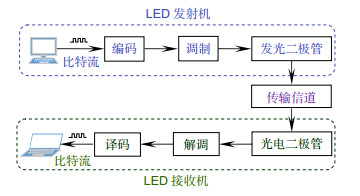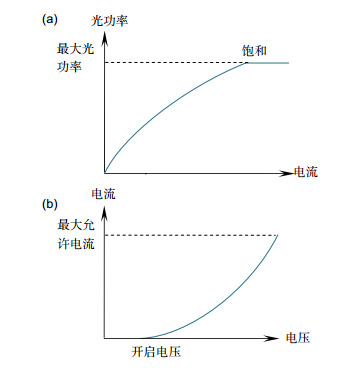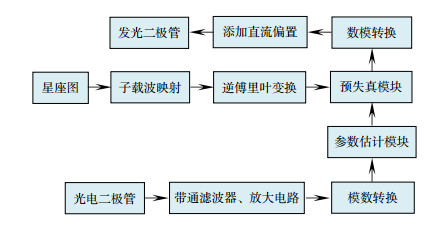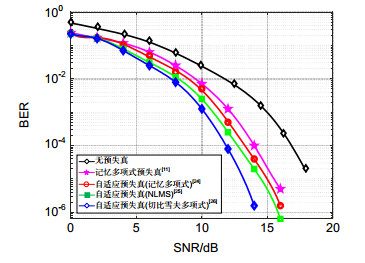LED nonlinearity compensation and bandwidth expansion techniques in visible light communication
-
摘要:
可见光通信(VLC)是一项有前景的技术,作为现有无线通信网络的有益补充,可提供高速率、低延迟及多设备接入等通信服务。借助传统无线通信的高性能编码调制技术,已经设计并实现了各种适配于VLC系统的物理层通信技术。不同于传统射频通信,VLC采用LED作为信号的发射源,LED的调制容易产生非线性失真且调制带宽有限,已成为VLC高速通信的技术瓶颈。针对这两方面的挑战,本文以白光LED为出发点,阐述了白光LED能有效兼顾照明和通信的特性,总结和分类了非线性失真补偿和拓展调制带宽的多种技术,最后本文提出了LED封装材料及工艺、新型Micro-LED器件研究、光源布局设计、码间干扰消除技术等开放性研究问题,以期提高可见光通信系统的性能。
Abstract:Visible light communication (VLC) is a promising technology that complements existing wireless communication networks to provide high-speed, low-latency, and multi-device access. With the high-performance code modulation technology of traditional wireless communication, various physical layer communication technologies adapted to VLC systems have been designed and implemented. Different from traditional radio frequency (RF) communication, VLC uses LED as the signal source. The modulation of LED is easy to produce nonlinear distortion and the modulation bandwidth is limited. It has become the technical bottleneck of VLC high-speed communication. In view of the challenges of these two aspects, taking white LED as the starting point, this paper expounds that white LED can effectively balance the characteristics of illumination and communication, summarizes and classifies various techniques of nonlinear distortion compensation and extended modulation bandwidth. Finally, this paper proposes open research issues such as LED package materials and processes, new Micro-LED device research, light source layout design, and intercode interference cancellation technology are expected to improve the performance of visible light communication systems.
-

Overview: Visible light communication (VLC) is a promising technology that can be used as a useful complement to existing wireless communication networks, it can provide high speed, low latency and multi-device access communication services. With the help of high performance coding modulation technology of traditional wireless communication, a variety of physical layer communication technologies adapted to VLC system have been designed and implemented. Different from traditional radio frequency communication, VLC use LED as the transmitting source of signals. The modulation of LEDs is prone to produce nonlinear distortion and limits the modulation bandwidth, which has become the technical bottleneck of VLC high-speed communication. According to these two challenges, with white LED as the starting point, this paper expounds the characteristics of white LED that can effectively both illumination and communications, and then summarizes and classifies a variety of technologies for the nonlinear distortion compensation and extension of the LED modulation bandwidth. In view of the nonlinear distortion compensation technology, this paper enumerates pre-distortion compensation scheme such as the pre-distortion circuit model, memory polynomial model, adaptive pre-distortion model, and post-distortion compensation schemes which include the decision feedback equalization model, adaptive distortion model, the frequency domain equalization. However, a lot of limitations in nonlinear model, computational complexity, additional physical feedback loop, model structure and other indicators need to be improved and optimized. For the LED bandwidth expansion technology, the paper classifies and discusses the pre-equalization technology and post-equalization technology that expanding the bandwidth of white LED can further improve the communication performance of the system and reduce the cost of the system. It is necessary to further study the software indicators such as adjust the circuit complexity, circuit debugging difficulty, circuit stability, sensitivity of component hardware index and computing resources, complexity of model structure. The advantages and disadvantages of the pre-distortion compensation technology and LED bandwidth expansion and the complexity of the design are summarized from the receiver and transmitter to further optimize the system. This team adopted pre-distortion technology and analog pre-equalization technology at the transmitter, and added digital post-equalization technology at the receiver to optimize the performance of VLC. At last, in order to improve the performance of visible light communication system, this paper puts forward some open research problems, such as LED packaging materials and technology, new micro-LED device research, light source layout design, inter-code interference elimination technology.
-

-
表 1 不同类别LED的比较
Table 1. Comparison of different types of LEDs
表 2 预失真经典方法总结
Table 2. Pre-distortion classic method summary
表 3 预均衡技术进展及对比
Table 3. Compare with pre-equalization method
预均衡类型 均衡技术 LED形态 带宽/MHz 传输速率/(Mbit/s) 代表性文献 硬件 串联谐振电路 荧光粉LED 2.5~45 80 [35] 硬件 晶体管T型电路 RGB LED 6.2~91 477 [39] 硬件 无源超前矫正电路 荧光粉LED 12~77.6 200 [33] 硬件 NPN型晶体管电路 荧光粉LED 3~175 460 [40] 硬件 改进型Bias-T电路 荧光粉LED 1.0~30 190 [38] 硬件 单级联T幅度均衡器 RGB LED 75~125 750 [41] 硬件 双级联T幅度均衡器 荧光粉LED 17~366 1600 [42] 软件 幂指数均衡 荧光粉LED 500 2080 [43] -
[1] Shiu Y S, Chang S Y, Wu H C, et al. Physical layer security in wireless networks: a tutorial[J]. IEEE Wireless Communications, 2011, 18(2): 66-74. doi: 10.1109/MWC.2011.5751298
[2] Liu J, Sando J, Li W, et al. Long distance optical Wireless network employing multiple access scheme[C]//Proceedings of 2007 IEEE Global Telecommunications Conference, Washington, DC, USA, 2007: 2258-2262.
[3] Green R J, Joshi H, Higgins M D, et al. Recent developments in indoor optical wireless systems[J]. IET Communications, 2008, 2(1): 3-10. doi: 10.1049/iet-com:20060475
[4] Singh S, Kakamanshadi G, Gupta S. Visible light communication an emerging wireless communication technology[C]// Proceedings of the 2015 2nd International Conference on Recent Advances in Engineering & Computational Sciences, Chandigarh, 2015: 1-3.
[5] Kottke C, Habel K, Grobe L, et al. Single-channel wireless transmission at 806 Mbit/s using a white light LED and a PIN based receiver[C]//Proceedings of the 2012 14th International Conference on Transparent Optical Networks, Coventry, UK, 2012: 1-4.
[6] Zhu X, Wang F M, Shi M, et al. 10.72Gb/s visible light communication system based on single packaged RGBYC LED utilizing QAM-DMT modulation with hardware pre-equalization[C]// Proceedings of Optical Fiber Communication Conference 2018, San Diego, 2018: 11-15.
[7] Pathak P H, Feng X T, Hu P F, et al. Visible light communication, networking, and sensing: a survey, potential and challenges[J]. IEEE Communications Surveys & Tutorials, 2015, 17(4): 2047-2077.
[8] Dimitrov S, Haas H. Information rate of OFDM-based optical wireless communication systems with nonlinear distortion[J]. Journal of Lightwave Technology, 2013, 31(6): 918-929. doi: 10.1109/JLT.2012.2236642
[9] Zhao S, Cai S Z, Kang K, et al. Optimal transmission power in a nonlinear VLC system[C]//Proceedings of 2015 IEEE Global Conference on Signal and Information Processing, Orlando, 2015: 1180-1184.
[10] 王灿, 周盈君, 迟楠.可见光通信中抗非线性方法的比较研究[J].中国照明电器, 2017(7): 9-15, 26. doi: 10.3969/j.issn.1002-6150.2017.07.002
Wang C, Zhou Y J, Chi N. Research of LED's nonlinear distortion compensation algorithm in visible light communications[J]. China Light & Lighting, 2017(7): 9-15, 26. doi: 10.3969/j.issn.1002-6150.2017.07.002
[11] Elgala H, Mesleh R, Haas H. Non-linearity effects and predistortion in optical OFDM wireless transmission using LEDs[J]. International Journal of Ultra Wideband Communications and Systems (IJUWBCS), 2009, 1(2): 143-150. doi: 10.1504/IJUWBCS.2009.029003
[12] Ying K, Yu Z H, Baxley R J, et al. Nonlinear distortion mitigation in visible light communications[J]. IEEE Wireless Communications, 2015, 22(2): 36-45. doi: 10.1109/MWC.2015.7096283
[13] 迟楠, 周盈君, 赵嘉琦, 等.基于硬件预均衡电路的高速可见光通信系统[J].科技导报, 2016, 34(16): 144-149. http://www.wanfangdata.com.cn/details/detail.do?_type=perio&id=kjdb201616023
Chi N, Zhou Y J, Zhao J Q, et al. High speed visible light communication based on hardware preequalization circuit[J]. Science & Technology Review, 2016, 34(16): 144-149. http://www.wanfangdata.com.cn/details/detail.do?_type=perio&id=kjdb201616023
[14] 迟楠. LED可见光通信关键器件与应用[M].北京:人民邮电出版社, 2015: 8.
Chi N. Key Devices and Applications of LED Visible Light Communication[M]. Beijing: Post & Telecom Press, 2015: 8.
[15] Steigerwald D A, Bhat J C, Collins D, et al. Illumination with solid state lighting technology[J]. IEEE Journal of Selected Topics in Quantum Electronics, 2002, 8(2): 310-320. doi: 10.1109/2944.999186
[16] Karunatilaka D, Zafar F, Kalavally V, et al. LED based indoor visible light communications: state of the art[J]. IEEE Communications Surveys & Tutorials, 2015, 17(3): 1649-1678.
[17] Neokosmidis I, Kamalakis T, Walewski J W, et al. Impact of nonlinear LED transfer function on discrete multitone modulation: analytical approach[J]. Journal of Lightwave Technology, 2009, 27(22): 4970-4978. doi: 10.1109/JLT.2009.2028903
[18] Tsonev D, Sinanovic S, Haas H. Complete modeling of nonlinear distortion in OFDM-based optical wireless communication[J]. Journal of Lightwave Technology, 2013, 31(18): 3064-3076. doi: 10.1109/JLT.2013.2278675
[19] Ghassemlooy Z, Alves L N, Zvanovec S, et al. Visible Light Communications: Theory and Applications[M]. Boca Raton: CRC Press, 2017.
[20] Jiang F Y, Zhang J L, Xu L Q, et al. Efficient InGaN based yellow-light-emitting diodes[J]. Photonics Research, 2019, 7(2): 144-148. http://d.old.wanfangdata.com.cn/NSTLQK/NSTL_QKJJ028753078/
[21] 刘军林, 莫春兰, 张建立, 等.五基色LED照明光源技术进展[J].照明工程学报, 2017, 28(1): 1-4, 29. http://d.old.wanfangdata.com.cn/Periodical/zmgcxb201701006
Liu J L, Mo C L, Zhang J L, et al. Progress of five primary colours LED lighting source technology[J]. China Illuminating Engineering Journal, 2017, 28(1): 1-4, 29. http://d.old.wanfangdata.com.cn/Periodical/zmgcxb201701006
[22] Kamalakis T, Walewski J W, Ntogari G, et al. Empirical volterra series modeling of commercial light-emitting diodes[J]. Journal of Lightwave Technology, 2011, 29(14): 2146-2155. doi: 10.1109/JLT.2011.2157082
[23] Asatani K, Kimura T. Linearization of LED nonlinearity by predistortions[J]. IEEE Transactions on Electron Devices, 1978, 25(2): 207-212. doi: 10.1109/T-ED.1978.19061
[24] 姚赛杰, 徐浩煜, 汪亮友, 等. LED记忆非线性自适应预失真技术研究[J].中国激光, 2014, 41(11): 1105007. http://www.wanfangdata.com.cn/details/detail.do?_type=perio&id=zgjg201411025
Yao S J, Xu H Y, Wang L Y, et al. Research of adaptive predistortion technique for nonlinear LEDs with memory effects[J]. Chinese Journal of Lasers, 2014, 41(11): 1105007. http://www.wanfangdata.com.cn/details/detail.do?_type=perio&id=zgjg201411025
[25] Kim J K, Hyun K, Park S K. Adaptive predistorter using NLMS algorithm for nonlinear compensation in visible light communication system[J]. Electronics Letters, 2014, 50(20): 1457-1459. doi: 10.1049/el.2014.1835
[26] Mitra R, Bhatia V. Chebyshev polynomial based adaptive predistorter for nonlinear LED compensation in VLC[J]. IEEE Photonics Technology Letters, 2016, 28(10): 1053-1056. doi: 10.1109/LPT.2016.2528168
[27] Lu X Y, Zhao M M, Qiao L, et al. Non-linear compensation of multi-CAP VLC system employing predistortion base on clustering of machine learning[C]//Proceedings of Optical Fiber Communication Conference 2018, San Diego, 2018: 11.
[28] Stepniak G, Siuzdak J, Zwierko P. Compensation of a VLC phosphorescent white LED nonlinearity by means of volterra DFE[J]. IEEE Photonics Technology Letters, 2013, 25(16): 1597-1600. doi: 10.1109/LPT.2013.2272511
[29] Qian H, Yao S J, Cai S Z, et al. Adaptive postdistortion for nonlinear LEDs in visible light communications[J]. IEEE Photonics Journal, 2014, 6(4): 7901508. http://www.wanfangdata.com.cn/details/detail.do?_type=perio&id=3fe80c3b775d3efbb8625fe27c34d9fb
[30] Mitra R, Bhatia V. Adaptive sparse dictionary based kernel minimum symbol error rate post-distortion for nonlinear LEDs in visible light communications[J]. IEEE Photonics Journal, 2016, 8(4): 7905413.
[31] Wang Y Q, Huang X X, Zhang J W, et al. Enhanced performance of visible light communication employing 512-QAM NSCFDE and DDLMS[J]. Optics Express, 2014, 22(13): 15328-15334. doi: 10.1364/OE.22.015328
[32] 徐旭东.可见光通信中LED的非线性后失真补偿技术研究[J].微型机与应用, 2017, 36(22): 78-82, 90. http://d.old.wanfangdata.com.cn/Periodical/wxjyyy201722021
Xu X D. Nonlinear post distortion for LED in visible light communication[J]. Network and Communication, 2017, 36(22): 78-82, 90. http://d.old.wanfangdata.com.cn/Periodical/wxjyyy201722021
[33] Grubor J, Randel S, Langer K D, et al. Broadband information broadcasting using LED based interior lighting[J]. Journal of Lightwave Technology, 2008, 26(24): 3883-3892. doi: 10.1109/JLT.2008.928525
[34] Le Minh H, O'Brien D, Faulkner G, et al. High-speed visible light communications using multiple resonant equalization[J]. IEEE Photonics Technology Letters, 2008, 20(14): 1243-1245. doi: 10.1109/LPT.2008.926030
[35] Le Minh H, O'Brien D, Faulkner G, et al. 80 Mbit/s Visible Light Communications using pre-equalized white LED[C]// Proceedings of the 2008 34th European Conference on Optical Communication, Brussels, 2008: 1-2.
[36] Li H L, Chen X B, Guo J Q, et al. 200 Mb/s visible optical wireless transmission based on NRZ-OOK modulation of phosphorescent white LED and a pre-emphasis circuit[J]. Chinese Optics Letters, 2014, 12(10): 100604. doi: 10.3788/COL201412.100604
[37] Fujimoto N, Yamamoto S. The fastest visible light transmissions of 662 Mb/s by a blue LED, 600 Mb/s by a red LED, and 520 Mb/s by a green LED based on simple OOK-NRZ modulation of a commercially available RGB-type white LED using pre-emphasis and post-equalizing techniques[C]//Proceedings of the 2014 the European Conference on Optical Communication, Cannes, France, 2014: 1-3.
[38] Yeh C H, Chow C W, Chen H Y, et al. Adaptive 84.44-190 Mbit/s Phosphor LED Wireless Communication utilizing no blue filter at practical transmission distance[J]. Optics Express, 2014, 22(8): 9783-9788. doi: 10.1364/OE.22.009783
[39] Fujimoto N, Mochizuki H. 477 Mbit/s visible light transmission based on OOK-NRZ modulation using a single commercially available visible LED and a practical LED driver with a pre-emphasis circuit[C]//Proceedings of 2013 Optical Fiber Communication Conference and Exposition and the National Fiber Optic Engineers Conference, Anaheim, 2013: 1-3.
[40] Li H L, Chen X B, Guo J Q, et al. An analog modulator for 460 MB/S visible light data transmission based on OOK-NRS modulation[J]. IEEE Wireless Communications, 2015, 22(2): 68-73. doi: 10.1109/MWC.2015.7096287
[41] Huang X X, Shi J Y, Li J H, et al. 750Mbit/s visible light communications employing 64QAM-OFDM based on amplitude equalization circuit[C]//Proceedings of 2015 Optical Fiber Communications Conference and Exhibition, Los Angeles, 2015.
[42] Huang X X, Wang Z X, Shi J Y, et al. 1.6 Gbit/s phosphorescent white LED based VLC transmission using a cascaded pre-equalization circuit and a differential outputs PIN receiver[J]. Optics Express, 2015, 23(17): 22034-22042. doi: 10.1364/OE.23.022034
[43] Zhou Y J, Liang S Y, Chen S Y, et al. 2.08 Gbit/s visible light communication utilizing power exponential pre-equalization[C]// Proceedings of the 2016 25th Wireless and Optical Communication Conference, Chengdu, China, 2016.
[44] Grubor J, Lee S C J, Langer K D, et al. Wireless high-speed data transmission with phosphorescent white-light LEDs[C]// Proceedings of the 33rd European Conference and Exhibition of Optical Communication Post Deadline Papers, Berlin, Germany, 2007: 1-2.
[45] Le Minh H, O'Brien D, Faulkner G, et al. 100-Mb/s NRZ visible light communications using a postequalized white LED[J]. IEEE Photonics Technology Letters, 2009, 21(15): 1063-1065. doi: 10.1109/LPT.2009.2022413
[46] Tokgoz S C, Anous N, Yarkan S, et al. Performance improvement of white LED based VLC systems using blue and flattening filters[C]//Proceedings of 2019 International Conference on Advanced Communication Technologies and Networking, Rabat, Morocco, 2019: 1-6.
[47] Li H L, Chen X B, Huang B J, et al. High bandwidth visible light communications based on a post-equalization circuit[J]. IEEE Photonics Technology Letters, 2014, 26(2): 119-122. doi: 10.1109/LPT.2013.2290026
[48] 丁德强, 柯熙政, 李建勋. VLC系统的光源布局设计与仿真研究[J].光电工程, 2007, 34(1): 131-134. doi: 10.3969/j.issn.1003-501X.2007.01.030
Ding D Q, Ke X Z, Li J X. Design and simulation on the layout of lighting for VLC system[J]. Opto-Electronic Engineering, 2007, 34(1): 131-134. doi: 10.3969/j.issn.1003-501X.2007.01.030
[49] Komine T, Lee J H, Haruyama S, et al. Adaptive equalization system for visible light wireless communication utilizing multiple white LED lighting equipment[J]. IEEE Transactions on Wireless Communications, 2009, 8(6): 2892-2900. doi: 10.1109/TWC.2009.060258
[50] Li G Q, Hu F C, Zhao Y H, et al. Enhanced performance of a phosphorescent white LED CAP 64QAM VLC system utilizing deep neural network (DNN) post equalization[C]//Proceedings of 2019 IEEE/CIC International Conference on Communications in China, Changchun, China, 2019.
-


 E-mail Alert
E-mail Alert RSS
RSS
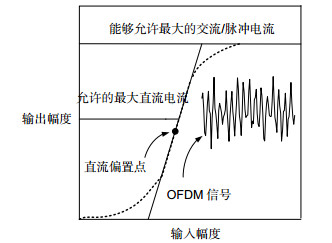
 下载:
下载:
